Classic French Steak Au Poivre
- By Jennifer Segal
- Updated August 8, 2025
- 66 Comments
- Leave a Review
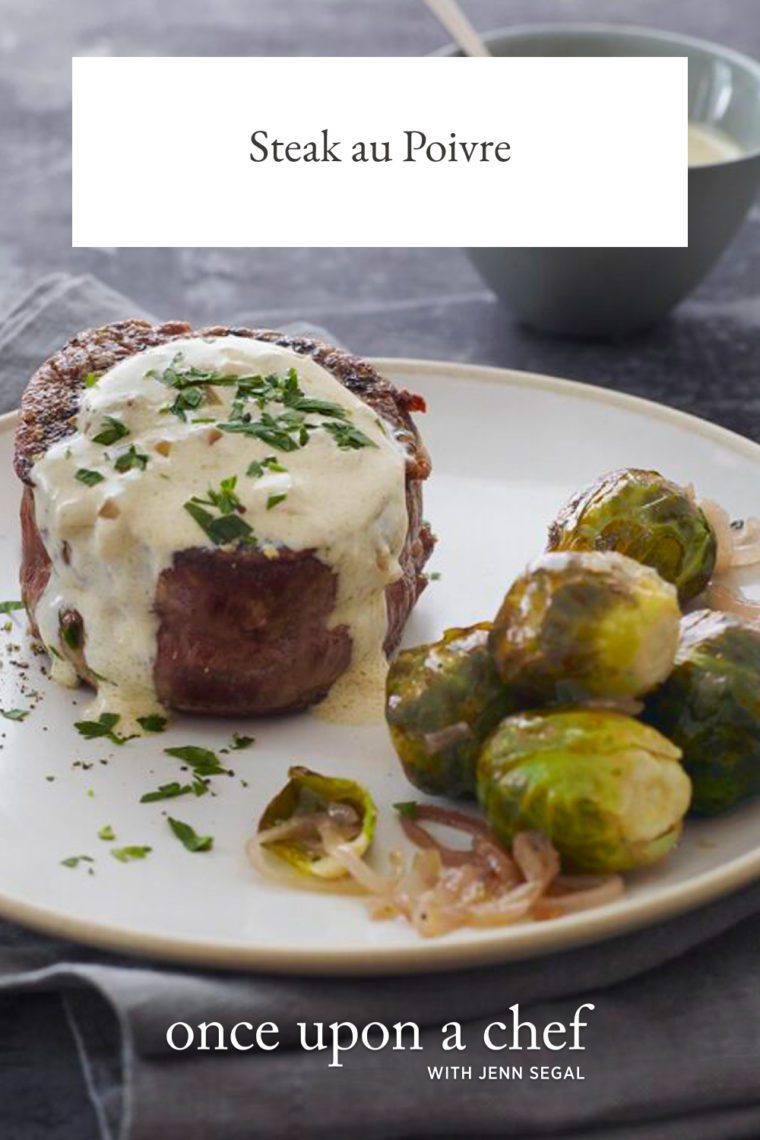
This post may contain affiliate links. Read my full disclosure policy.
Want to impress someone (or just treat yourself)? Learn to make steak au poivre at home: pan-seared steak crusted with cracked peppercorns and finished with a rich Cognac cream sauce.
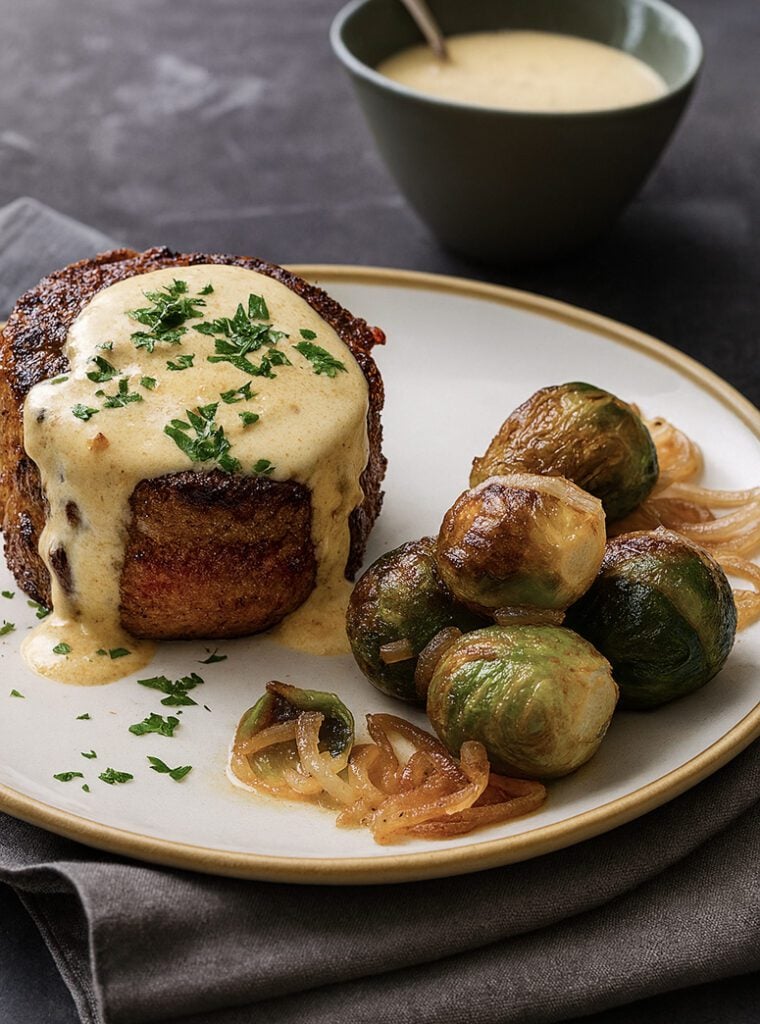
Steak au poivre is French for “pepper steak,” a classic bistro dish made with beef tenderloin or New York strip, crusted in coarsely crushed peppercorns and finished with a rich Cognac cream sauce.
I first learned to make this dish while working in a French restaurant, but I came to love it during my time living in France as an au pair. I can still picture my host mother, Valérie—an incredible home cook—crushing peppercorns with the back of a frying pan before searing the steaks in a blazing hot skillet.
This steak au poivre recipe stays true to the classic and is surprisingly simple to prepare. It’s often served with pommes frites, but my crispy potato wedges make a perfect—and easier—alternative. A simple roasted vegetable works well, too. To round out a bistro-style meal, start with French Onion Soup and finish with a classic French dessert like chocolate soufflé or crème brûlée.
“I made this for my husband on Valentine’s day and he said it was one of the best things I have ever cooked.”
What You’ll Need To Make Steak au Poivre
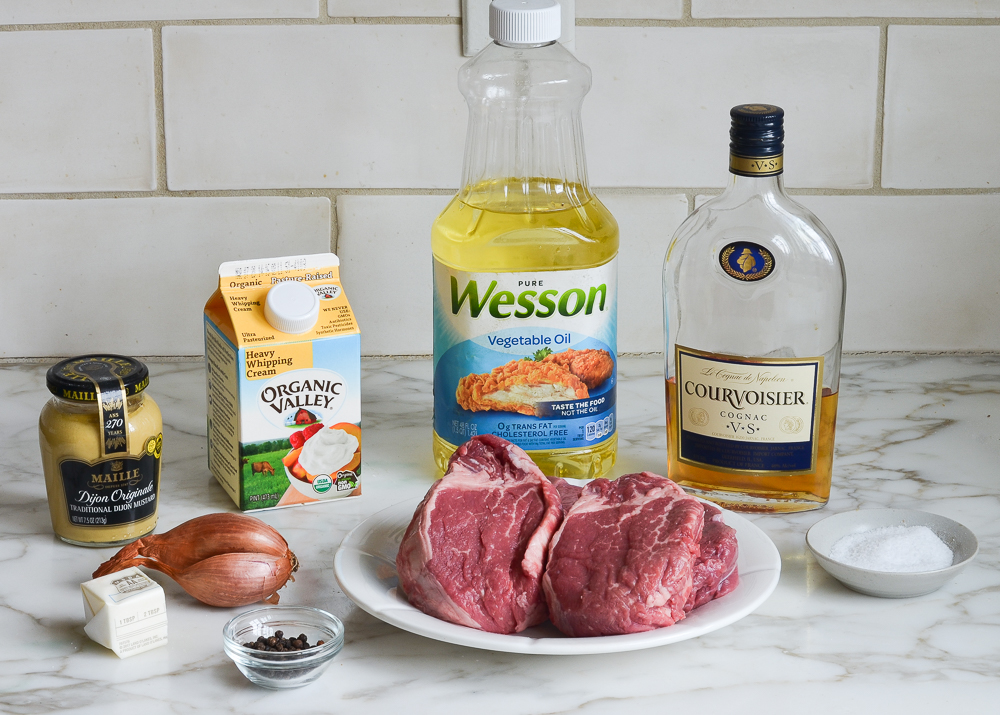
- Vegetable Oil: Used to sear the steaks for a rich, golden-brown crust; this type of oil stands up to the high heat required for a perfect sear.
- Filet mignons: Cut from the beef tenderloin, this lean, buttery-soft steak pairs nicely with the bold, peppery crust and rich, creamy sauce. New York strip steaks are also a great option if you prefer a heartier, more flavorful cut.
- Kosher salt and whole peppercorns: Kosher salt enhances the flavor of the steak and its coarse texture makes it easy to season evenly. Cracked black peppercorns form the signature spicy crust—don’t skimp! For a twist, you can swap in some green peppercorns, which are a bit milder.
- Unsalted Butter and shallots: Shallots cooked in butter add richness and depth of flavor to the sauce.
- Cognac: A splash deglazes the pan, picking up all those tasty browned bits and adding a touch of warmth and complexity to the sauce. Brandy works just as well if that’s what you have.
- Heavy cream: The key to the au poivre sauce’s creamy texture, it balances the heat of the peppercorns and enriches the flavor.
- Dijon mustard: Just a spoonful adds a gentle tang and depth you wouldn’t get from yellow mustard.
- Jump to the printable recipe for precise measurements
How to Make Steak Au poivre
Step 1: Prep the whole peppercorns. Seal the peppercorns inside a small plastic bag and place on a cutting board. Use a meat pounder to pound the peppercorns until they are coarsely crushed.
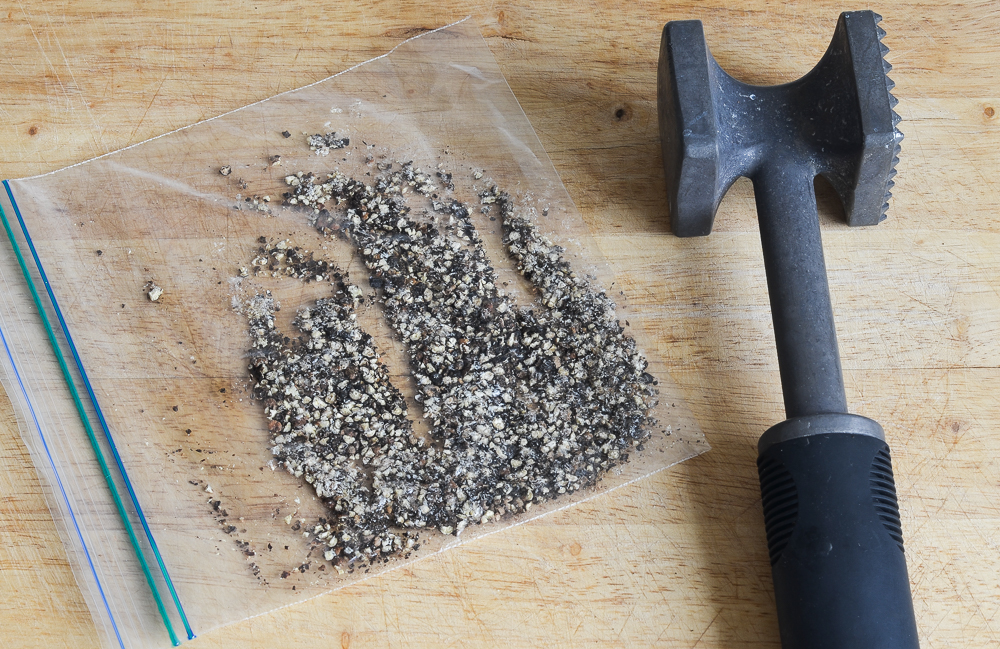
Step 2: Prep the steaks. Pat the steaks dry. If they are thick, gently press them down so that they are about 1½ inches tall. Season the steaks all over with the crushed peppercorns and kosher salt. Press it into the meat to make sure the seasoning adheres.
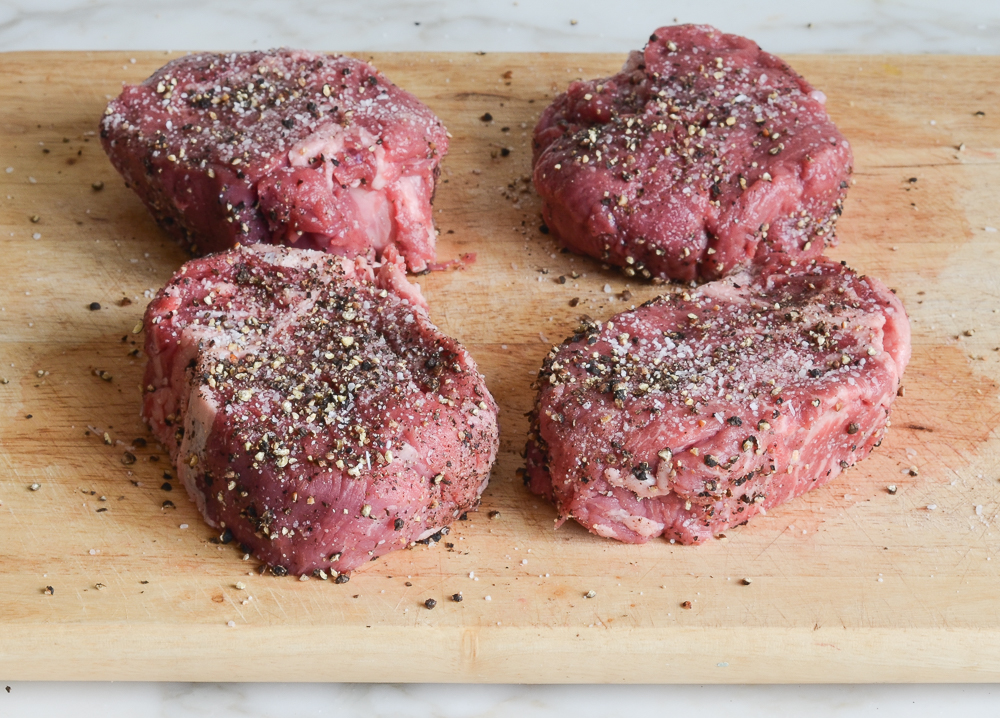
Step 3: Sear the steaks. Heat the oil in a heavy-bottomed pan over medium-high heat until it’s hot and shimmering. Add the steaks and let them cook undisturbed for about 4 minutes—you want a deep, golden crust to form, so resist the urge to move or fuss with them.
Pro tip: Use a heavy pan like cast iron or stainless steel. Cast iron holds heat exceptionally well, giving you an even, consistent sear, while stainless steel heats quickly and evenly—perfect for browning and building flavor for the sauce.
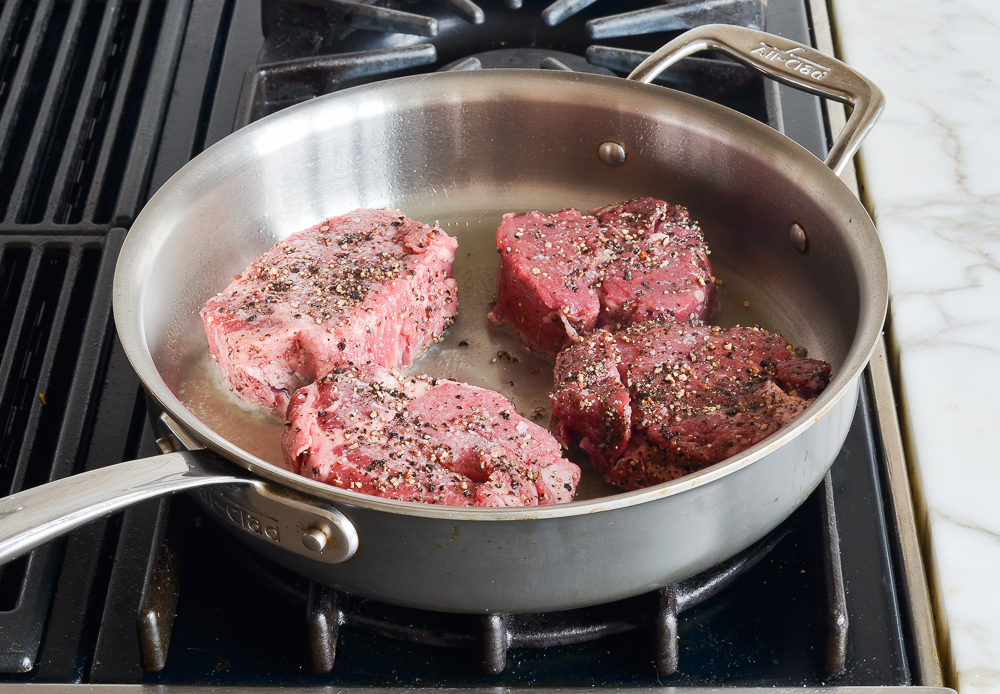
Step 4: Flip. Turn the steaks and cook for about 4 minutes more for medium-rare, or 5 minutes per side if you prefer them medium. Transfer the steaks to a plate and tent loosely with foil to keep warm while you make the sauce.
🔥 Doneness Tip: Use a meat thermometer to determine doneness. Aim for these internal temps: 120–125°F for rare, 130–135°F for medium-rare, 135–145°F for medium. The steaks will continue to cook slightly as they rest.
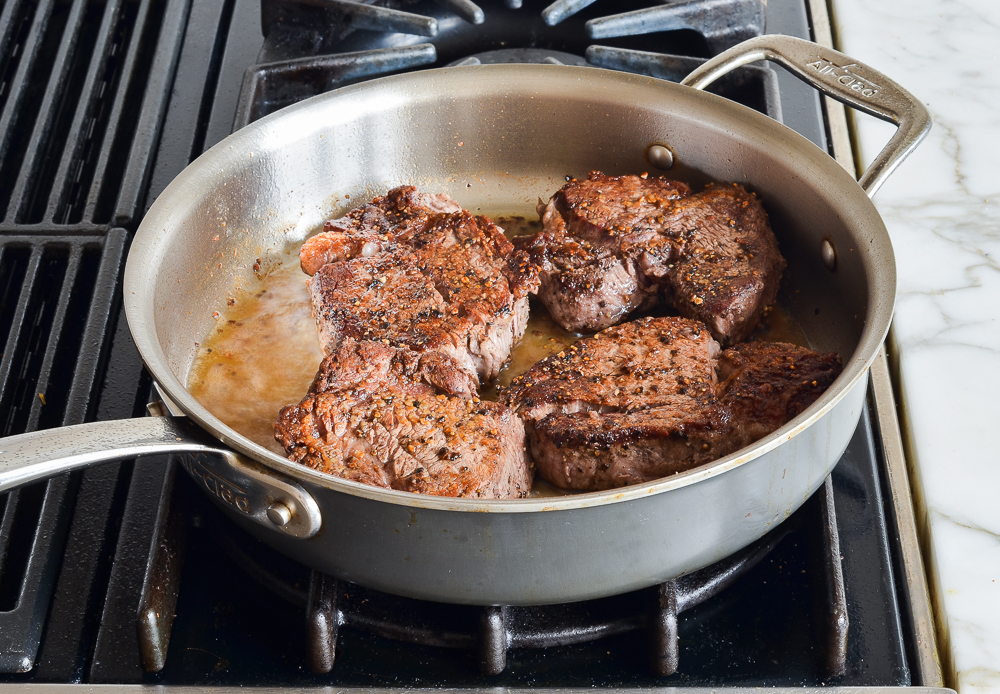
Step 5: Start the sauce. Pour off the excess fat from the pan but do not wipe clean. Lower the heat to medium-low and add the butter and shallots. Cook, stirring constantly with a wooden spoon and scraping up the brown bits, until the shallots are golden brown and softened, 2 to 3 minutes.
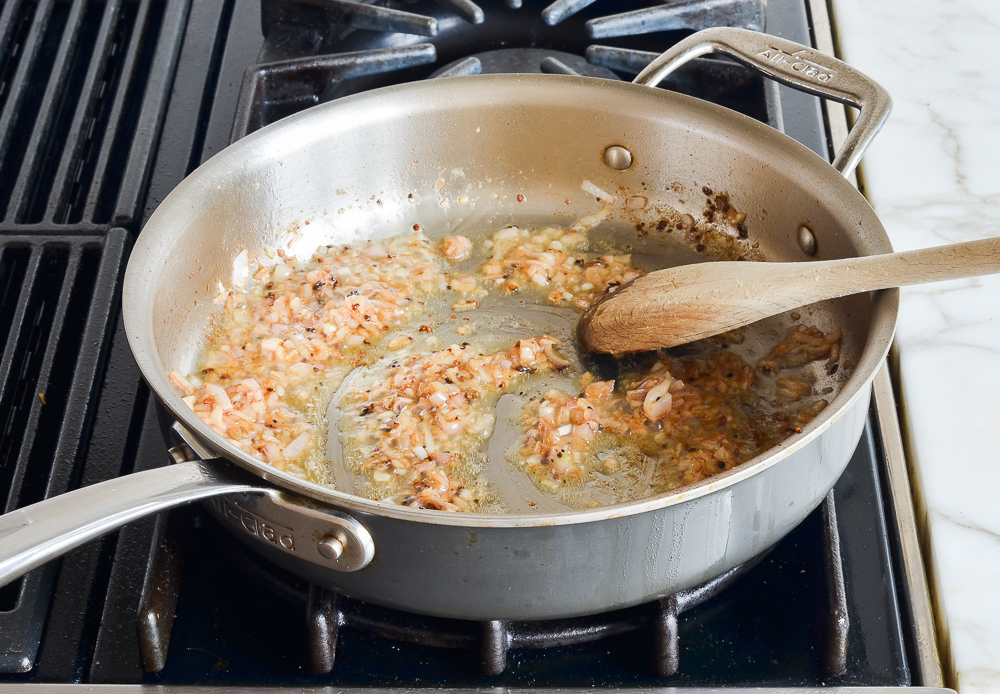
Step 6: Add the Cognac. Carefully add the Cognac and bring to a boil, stirring to scrape up the browned bits from the bottom of the pan. You can flambé the alcohol if you’d like, but it’s not necessary—simmering will burn it off just the same.
🔥 Be Cautious. When you add the Cognac, it may flare up—especially if you’re cooking over a gas flame. The alcohol can ignite unexpectedly, and the flames can leap higher than you’d expect (sometimes a little too close to your cabinets!). To stay on the safe side, you can remove the pan from the heat before adding the Cognac, then return it to the burner once the alcohol has burned off.
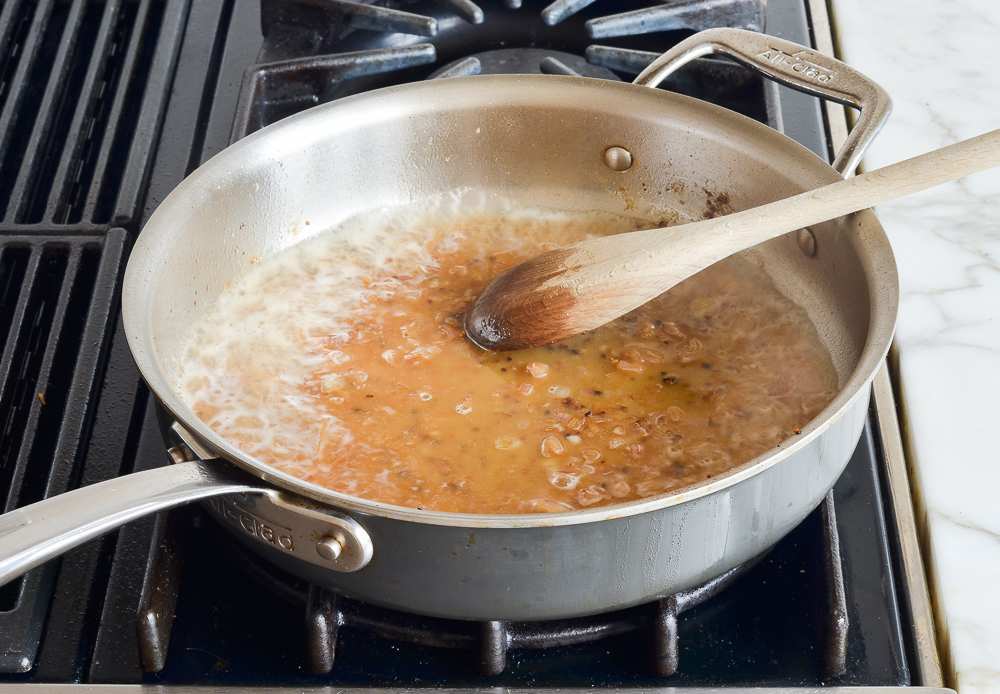
Step 7: Reduce. Cook the until the liquid is reduced to a glaze and mostly absorbed by the shallots. This will take a few minutes.

Step 8: Finish the sauce. Add the cream and mustard to the shallots, and bring to a gentle boil. Simmer until the au poivre sauce thickens enough to coat the back of a spoon, about 3 minutes. Stir in any meat juices that accumulated on the plate—this adds tons of flavor.
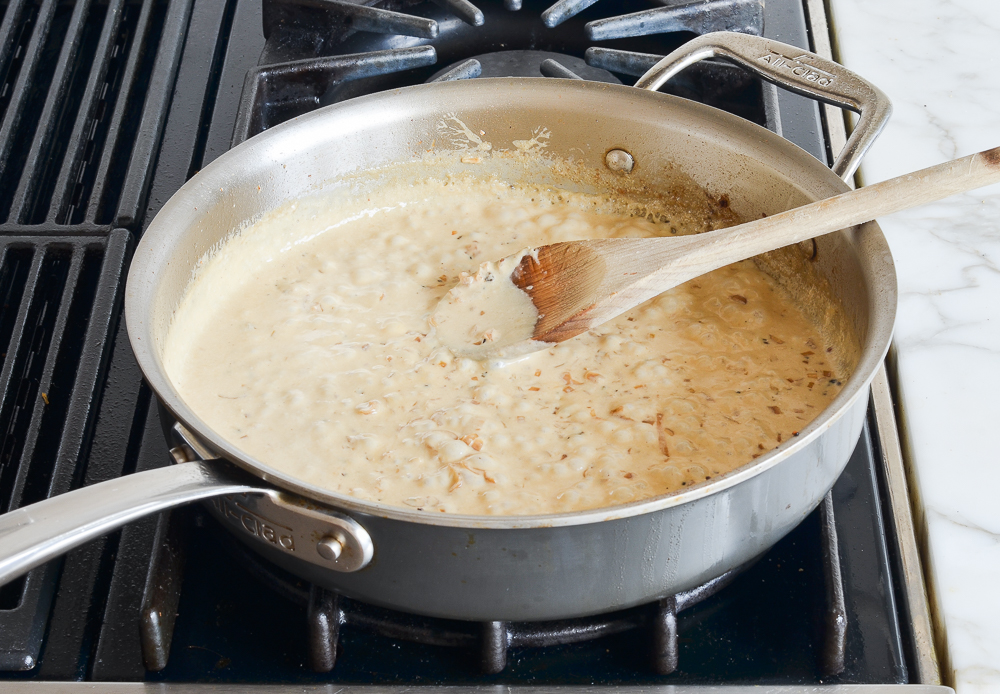
Step 9: Serve. Transfer the steaks to plates and spoon the Cognac peppercorn sauce over top.
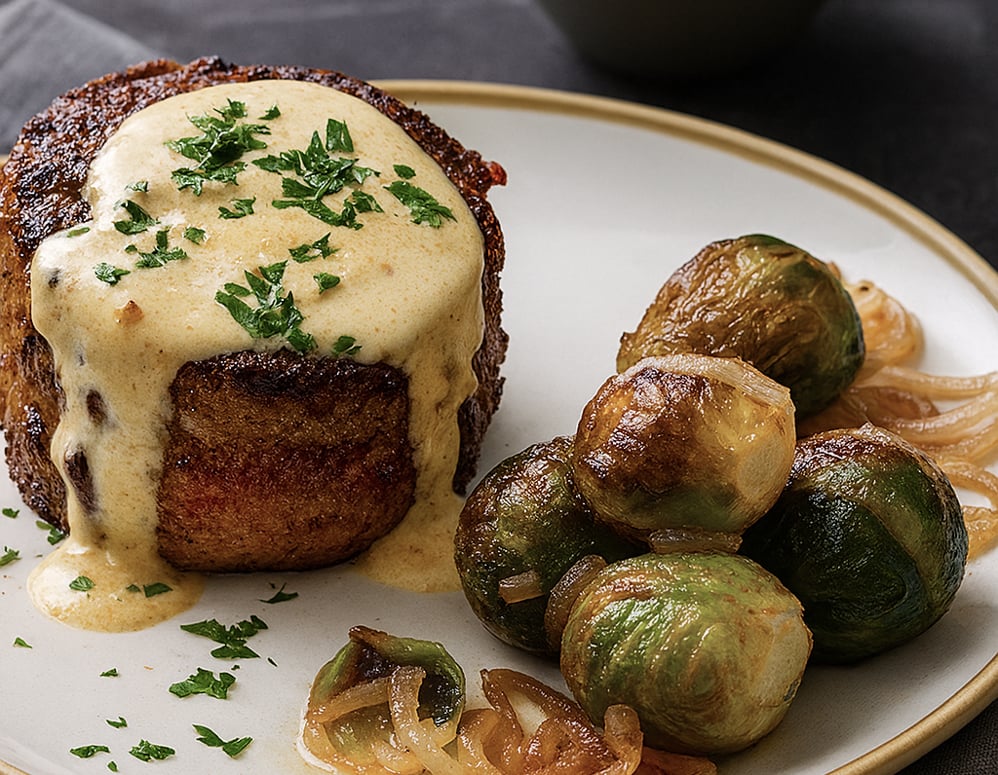
Video Tutorial
More French Recipes You May Like
Steak au Poivre
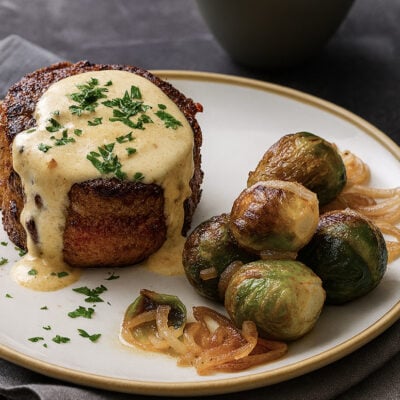
Ingredients
- Four (6- to 8-oz) filet mignons
- 1 heaping teaspoon kosher salt
- 1 tablespoon whole peppercorns
- 1 tablespoon vegetable oil
- 2 tablespoons unsalted butter
- ⅓ cup finely chopped shallots, from 1 medium shallot
- ½ cup Cognac or other brandy
- ¾ cup heavy cream
- 1 teaspoon Dijon mustard
Instructions
- Pat the steaks dry and, if they are thick, gently press them down so that they are about 1½ in (4 cm) thick. Season the steaks all over with the salt.
- Seal the peppercorns inside a small plastic bag and place on a cutting board. Using a meat mallet or the bottom of a frying pan, pound the peppercorns until they are coarsely crushed. Press the crushed pepper evenly onto both sides of the steaks.
- In a large stainless steel or cast iron skillet, heat the oil over medium-high heat. When the oil is hot and shimmering, add the steaks and cook about 4 minutes on each side, turning only once, for medium-rare (or about 5 minutes per side for medium). Transfer the steaks to a plate and tent with foil.
- Pour off the excess fat from the pan but do not wipe clean. Lower the heat to medium-low and add the butter and shallots. Cook, stirring constantly with a wooden spoon and scraping up the brown bits, until the shallots are golden brown and softened, 2 to 3 minutes. Carefully add the Cognac (it may ignite) and boil, again stirring to scrape up the brown bits, until the liquid is reduced to a glaze and mostly absorbed by the shallots, a few minutes. Add the cream and mustard and gently boil until thickened, about 3 minutes. Stir in any meat juices that accumulated on the plate. Transfer the steaks to plates and spoon the sauce over top.
Pair with
Nutrition Information
This website is written and produced for informational purposes only. I am not a certified nutritionist and the nutritional data on this site has not been evaluated or approved by a nutritionist or the Food and Drug Administration. Nutritional information is offered as a courtesy and should not be construed as a guarantee. The data is calculated through an online nutritional calculator, Edamam.com. Although I do my best to provide accurate nutritional information, these figures should be considered estimates only. Varying factors such as product types or brands purchased, natural fluctuations in fresh produce, and the way ingredients are processed change the effective nutritional information in any given recipe. Furthermore, different online calculators provide different results depending on their own nutrition fact sources and algorithms. To obtain the most accurate nutritional information in a given recipe, you should calculate the nutritional information with the actual ingredients used in your recipe, using your preferred nutrition calculator.
Gluten-Free Adaptable Note
To the best of my knowledge, all of the ingredients used in this recipe are gluten-free or widely available in gluten-free versions. There is hidden gluten in many foods; if you're following a gluten-free diet or cooking for someone with gluten allergies, always read the labels of your ingredients to verify that they are gluten-free.
See more recipes:
Comments
Add a Comment Cancel reply
This site uses Akismet to reduce spam. Learn how your comment data is processed.

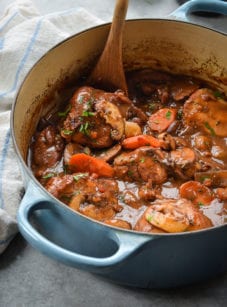


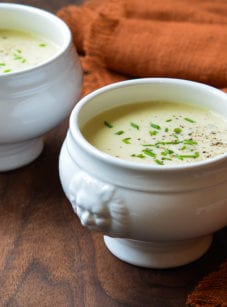
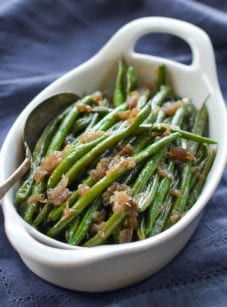
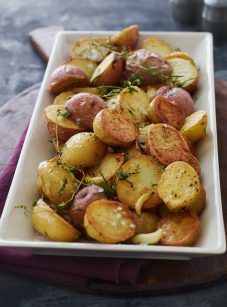
Jenn, this recipe is one of my family favourites – it’s so delicious and tastes just like we were eating at a restaurant in France. I have an odd question. I am hosting a large group (12 people) and I don’t think it’s practical for me to prepare 12 steaks – but I would love to try to serve this recipe. I was thinking of trying a hybrid of this recipe and your Beef Tenderloin Roast recipe – e.g. prep the tenderloin roasts with the salt & peppercorns, sear the roasts before finishing in the oven. I would make the sauce for this steak au poivre recipe, but just increase the quantity. Thoughts? Thanks again for all your wonderful recipes!
Hi Michelle, glad you like it! I think what you’re suggesting would work nicely. Please LMK how everything comes out if you try it!
Can you make the sauce ahead of time and reheat?
Hi Rosanne, I don’t recommend it — you’d need to sear the steaks in order to get the browned bits on the bottom of the pan to add flavor to the sauce.
Hi Jenn. We love this recipe (and your web site/cookbooks) and use them all the time. I’m curious about one thing. Given we’re already adding kosher salt to the steak, why the need for unsalted butter?
Hi Mike, so glad you like this! The primary reason I call for unsalted butter in recipes is that the amount of salt in salted butter varies by brand. This makes it harder to calibrate the rest of your seasoning in the recipe.
I made this for my valentine this past Friday. It was fabulous and simple. He loved it!
So did I!
Any provisions to make if cooking two steaks instead of four? Thank you!
Hi Andrew, if you’re cutting all the ingredients in half, I’d use a smaller skillet so the sauce reduces appropriately. Hope you enjoy!
Thank you. To be clear, maybe a 10 inch skillet for two and a 12 inch skillet for four steaks?
A 10-inch skillet is fine, but for that size, I’d keep the amount of sauce the same instead of halving it.
I’m looking forward to making this tomorrow for my son’s visit! Question- can I use green peppercorns, as that’s what I have?
Hi Deb, I don’t recommend green peppercorns for this — sorry!
i’ve cooked steaks, been to top steakhouses–this was as good or better than them all; a couple of points to consider; readers should be told to preferably purchase a center cut, rounded filet, since there are others in the meat case that aren’t uniformly thick, creating a cooking dilemma; 2d, here many of the tenderloins are bigger than 1.5 inch, and preferred that way by some; these may be apt to get too charred on the outside, while also creating a lot of smoke in the kitchen; i tried one reviewer’s suggestion(that would be worth noting in recipe area) of finishing the steak in the oven–worked perfectly–just have a good meat thermometer…
I have never cooked a typical steak in my life – I generally leave that to my husband as he prepares a wonderful steak on the stovetop. However, it was our anniversary and I was wanted to surprise him with an elegant dinner. This steak recipe was perfect! Cooked about 5-6 minutes on each side because our filet mignons were a little thicker than the 1.5 inches. It was so good, especially considering this was my first attempt! Served with Jenn’s suggestion of roasted potatoes and French green beans. I make these sides all the time and they are easy, but still elevated enough to make a wonderful special dinner. Amazing!! And the sauce is sooo good!! Thank you for making our anniversary so special!!
This was fabulous! And easy. Cooked on cast iron skillet on stovetop. Thank you!